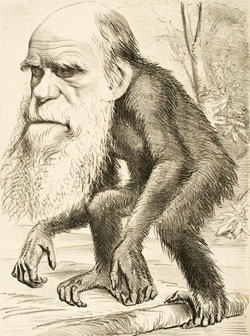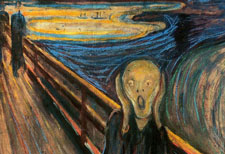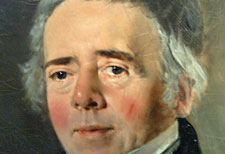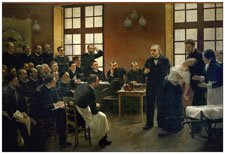
The Industrial Revolution and Romanticism
In the 19th century, natural philosophy branched out into the specialised sciences, Darwin’s theory of evolution created uproar and great progress was made in technology.
At the so-called world exhibitions that were very popular in the 19th century, curiosities from distant lands were on display, as well as advances in science and technology. The Great Exhibition in London in 1851, in particular, attracted a great deal of attention - here the exhibition was gathered in the Crystal Palace, a colossal building of glass and cast iron. The building style was innovative, and the Crystal Palace became a symbol of England as the flagship of industrialism. The Industrial Revolution began in Great Britain from about 1760, and reached the rest of Europe during the 19th century.
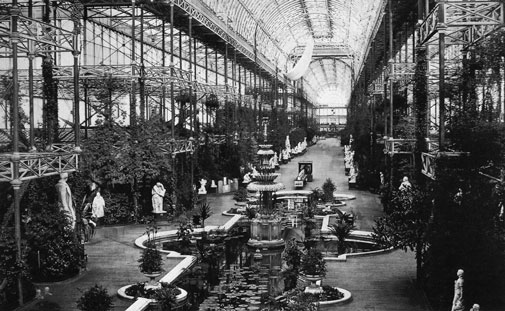
While the Crystal Palace signaled a new era, it can also be seen as a continuation of the rationalism of the Enlightenment - the light that shone through the entire building could reference the unexplored elements that were illuminated, systematised and passed on. The photograph shows part of the exhibition in the greenhouse-like Crystal Palace.
"It is certainly correct to describe the rampant nervousness as one of the greatest curses of modern society. Not only does it testify to the increasing frequency of mental illness and suicide, but it contributes considerably to mark our time with its singular character. The greater speed, which nowadays has come into existence, the unrest and haste that characterises all circumstances, is the expression for an intensive internal life; but the greater the demands made on the nervous system, the easier it is drained of its power, the sooner it loses its resistance. (...) Herein we may also search for one of the reasons that we, despite all of our triumphs in the sciences and the sphere of practical inventions, have far from achieved a golden age of health, happiness or satisfaction.”
This is how the Danish physician (and brother of the author Henrik Pontoppidan), Knud Pontoppidan, described the psychological consequences of life in the modern city. Quote from Neurasthenia, A contribution to the description of the nervousness of our age, 1886.
While the Crystal Palace signaled a new era, it can also be seen as a continuation of the rationalism of the Enlightenment - the light that shone through the entire building could reference the unexplored elements that were illuminated, systematised and passed on. The photograph shows part of the exhibition in the greenhouse-like Crystal Palace.
Technology brought many changes: The steam engine was introduced, and the railroad quickly spread. The telegraph, the photograph and the automobile were invented, and people flocked to the cities with the advent of industrialisation. The appearance of nervous disorders was traced to the hectic city life, where horse-drawn carriages, automobiles and people were fighting for space and people wondered whether the human body would be damaged by travel in a train pulled by a steam locomotive at a speed that was not natural for the body.
Turner and the Industrial Revolution
In Rain, Steam and Speed – the Great Western Railway (1844) by Joseph Mallord William Turner (1775-1851), a steam locomotive approaches from a distance. The image can be interpreted as a reflection of industrialisation - the steam locomotive passes over The Great Western Railway Bridge – an innovative construction, the safety of which was in doubt, but which is still in use today. The river is the Thames and the view looks east, in the direction of London.
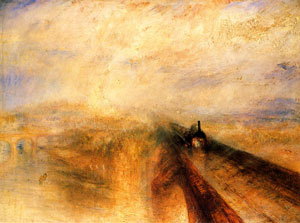 One critic remarked that one should hurry to see the painting before the locomotive had driven out of the canvas. Out of the gentle tones of the landscape, the locomotive and the dark nuances of the bridge stand out clearly and the diagonal lines of the linear perspective indicate the speed of the train – Turner shows not only the change that society underwent, but also the increased speed of life in Turner’s time.
One critic remarked that one should hurry to see the painting before the locomotive had driven out of the canvas. Out of the gentle tones of the landscape, the locomotive and the dark nuances of the bridge stand out clearly and the diagonal lines of the linear perspective indicate the speed of the train – Turner shows not only the change that society underwent, but also the increased speed of life in Turner’s time.
Where the train and the bridge can be said to represent culture, human constructions, it is surrounded by the natural environment - the river, the rain and the sky. The closer one gets to the horizon line, the harder it is to distinguish between rain, steam, landscape, bridge and machine - culture and nature, which are traditionally set up as opposites, blend together.
Nature and culture
In Turner’s Snow Storm - Steam-boat off a Harbour’s Mouth (1842), on the other hand, it is nature that has overtaken one of the newly invented symbols of industrialism - the steamship. The painting depicts a violent storm where a ship is just barely discernable. In the almost abstract painting, the dramatic contrast between light and shadow, the diagonal lines and the fact that it is almost impossible to distinguish between sky and sea contribute to the viewer being left with a sense of chaos.
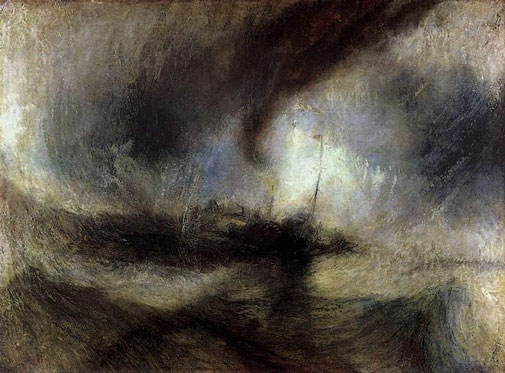
Snow Storm – Steam-boat off a Harbour’s Mouth is working with a motive and uses effects that can be used to evoke the feeling of the sublime. The sublime is a concept that was especially developed by theorists in the 18th century - one of these theorists was Immanuel Kant, who believed that magnificent or powerful natural phenomena could awaken the sense of something overwhelming, almost incomprehensible - the feeling of the sublime. While in the 18th century they to a greater degree theorised about the sublime, the Romantics began to try to evoke the feeling of the sublime in the late 18th century and early 19th century, through poems about, and paintings of, nature’s power and might.
Turner was one of the painters who were occupied by natural phenomena such as volcanic eruptions, storms and towering mountains, and can thus be associated with Romanticism. In art, Romanticism can be seen as a reaction against the rationalism that had been dominant in the 18th century, and Neoclassicism’s more straightforward design. The Romantics were concerned with feeling, individual expression, genius and going beyond.
The romantic philosophy of nature
It was not only in art that Romanticism had its time. In the romantic philosophy of nature, which primarily had followers in Germany, England and Scandinavia, no distinction was made between art and science - art was seen as a science and an important foundation for scientific progress.
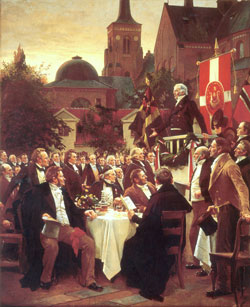
In this painting by Erik Henningsen, showing a festive banquet at a Scandinavian meeting of natural scientists in 1847, it is summer, the colours are clear and the flags are waving, while prominent figures in the arts and sciences concentratedly listen to H. C. Ørsted’s speech. It is noteworthy that the light that falls on the faces of the listeners seems to come from where Ørsted is, regardless of the listener’s position. Light as a metaphor for knowledge and education, which was particularly in vogue during the Enlightenment, is used here by Erik Henningsen.
The romantic natural philosophy, where one sought to raise morality, science and art to a higher level, can be seen as a further development of science and the Enlightenment belief in the future. Nature romantics promoted the idea of the brilliant scientist, who by seeing science as a part of a larger whole, could discover previously unknown relationships in nature.
One of those who spoke in favour of the romantic philosophy of nature was the Danish physicist, chemist and pharmacist Hans Christian Ørsted (1777-1851), who discovered that electric currents produce magnetic fields. For Ørsted science was a means of linking the true, the good and the beautiful and Ørsted was certainly not without influence in scientific circles in Denmark.
However, by the time of Ørsted’s death, the romantic philosophy of nature began to slip into the background in favour of positivism, which emphasised knowledge through experience.
Charles Darwin and evolution
For Ørsted, as for many others, faith and science complemented each other as parts of a larger whole. The relationship between science and religion was changed drastically by Charles Darwin’s (1809-82) publication of On the Origin of Species in 1859. Here Darwin laid out his theory of evolution, which showed that human evolution was due to natural selection, rather than a result of creation in six days.

In On The Origin of Species Darwin mentioned countless examples of the adaptation of different species and used fossils and finches from the Galapagos Islands as evidence for his theory of evolution. The illustration is by the ornithologist and artist John Gould (1804-81). It is said that it was Gould who pointed out to Darwin that you could link the characteristics of the birds to the environment they came from.
The conflict between the Christian creation story and Darwin’s theory of evolution created controversy in Darwin’s home country as well as internationally. Darwin was soon the victim of a number of cartoons. It is said that a picture is worth more than a 1000 words. Caricatures like this can be effective arguments - here Darwin’s credibility as a researcher, as well as his theory, are pushed to extremes and ridiculed.
In the caricature, the characteristics of a person or a situation are exaggerated so that the pictured is set in a humorous or satirical light. Darwin’s theory of the relationship between man and ape resulted in drawings like this, which was published in Hornet Magazine in 1871, where Darwin’s head is placed on a monkey’s body.
"When we look at the plants and bushes clothing an entangled bank, we are tempted to attribute their proportional numbers and kinds to what we call chance. But how false a view is this! (…) What a struggle between the several kinds of trees must here have gone on during long centuries, each annually scattering its seeds by the thousand; what war between insect and insect — between insects, snails, and other animals with birds and beasts of prey — all striving to increase, and all feeding on each other or on the trees or their seeds and seedlings, or on the other plants which first clothed the ground and thus checked the growth of the trees!”
From On the Origins of Species by Means of Natural Selection, or the Preservation of Favored Races in the Struggle for Life by Charles Darwin
However, Darwin’s theory eventually became widely accepted and in addition to revolutionising the philosophy of man and nature, it contributed to the controversy that followed the publication of On the Origin of Species, to a division between science and religion.
| << Previous | Next >> |
Art in the 19th century
|

